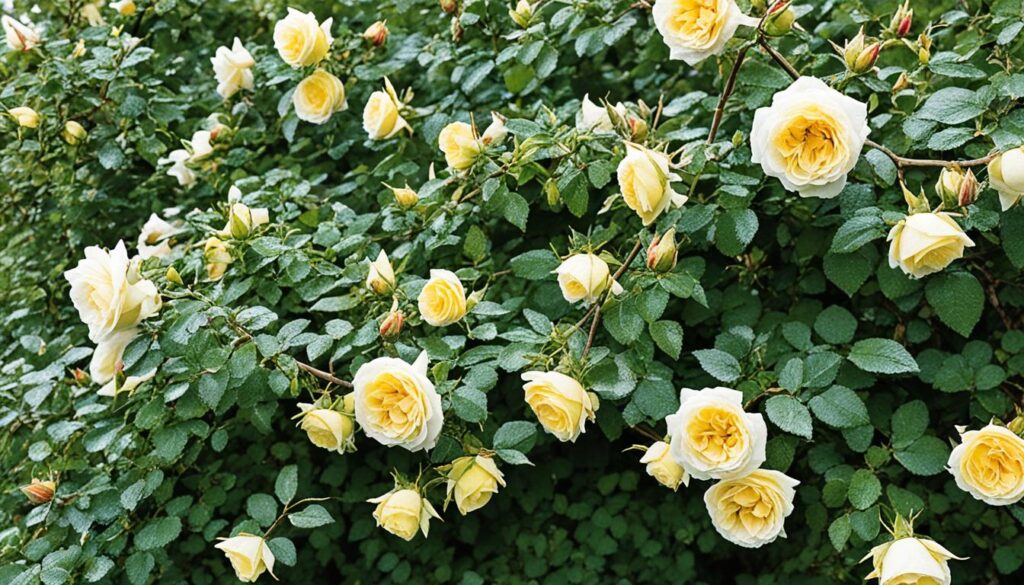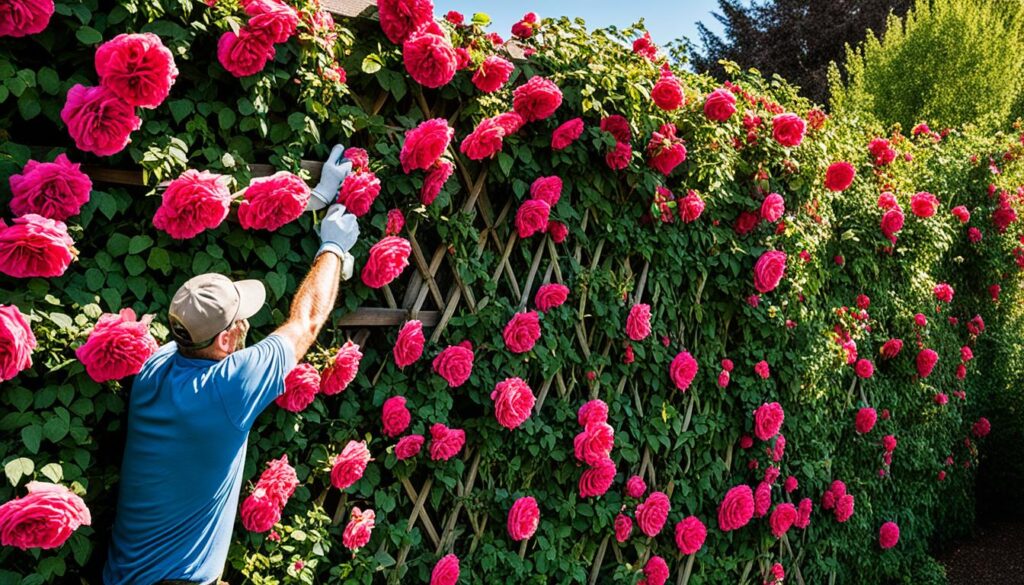When it comes to adding charm and drama to your garden, climbing roses are a fantastic choice. These vigorous plants, also known as Rosa setigera, are relatively easy to grow and can be trained to climb on fences, trellises, arbors, and trees. With their fragrant blooms in various colors, climbing roses can transform any landscape into a vibrant oasis.
To ensure your climbing roses thrive, it’s essential to provide them with the right care. Choosing a suitable location with full sun exposure, well-drained soil, and consistent watering are key factors in their success. Regular fertilization and pruning in the dormant months will help maintain their health and encourage abundant blooms. With several popular varieties to choose from, such as ‘New Dawn’, ‘Russell’s Cottage Rose’, and ‘Lady Banks’, you can find the perfect climbing rose to suit your preferences.
Key Takeaways:
- Choose a suitable location with full sun exposure for your climbing roses.
- Provide well-drained, loamy soil and consistent watering.
- Fertilize regularly with a balanced fertilizer and prune in the dormant months.
- Popular climbing rose varieties include ‘New Dawn’ and ‘Russell’s Cottage Rose’.
- Climbing roses can be propagated through stem cuttings or seeds.
Planting and Soil Requirements for Climbing Roses
If you’re looking to grow climbing roses, proper planting and soil preparation are key to their success. By following these guidelines, you can ensure that your climbing roses thrive and flourish in your garden.
Planting Climbing Roses
To get started with growing climbing roses, it’s best to plant them as bare-root, dormant plants in late winter or early spring. This allows the roots to establish themselves before the heat of summer sets in. When choosing a location, keep in mind that climbing roses require full sun exposure to thrive. However, they can tolerate some shade, especially in hot climates.
When it comes to soil requirements for climbing roses, they are relatively adaptable and can grow in various soil types. However, they thrive in rich, fertile, and loamy soil with good drainage. Adding organic matter such as compost, mulch, or peat moss can improve the soil quality and enhance drainage. This is particularly beneficial if you have heavy clay or sandy soil.
| Soil Requirements for Climbing Roses | |
|---|---|
| Sun Exposure | Full sun, with some tolerance for shade |
| Soil Type | Adaptable, but thrives in rich, fertile, loamy soil |
| Drainage | Requires good drainage |
| Organic Matter | Add compost, mulch, or peat moss to improve soil quality |
Consistent watering is crucial, especially during the first year of growth. However, avoid oversaturating the plants as this can lead to root rot. Aim for a balance by providing enough water to keep the soil moist but not overly wet.
How to Grow Climbing Roses
Climbing roses prefer moderate temperatures ranging from 50°F to 80°F (10°C to 27°C). They also thrive in relatively moderate humid environments. By understanding their ideal conditions, you can create the perfect environment for these beautiful and fragrant climbers to grow.
Now that you know how to plant and meet the soil requirements for climbing roses, let’s move on to the next section where we’ll explore training and support techniques to help your climbing roses reach their full potential.
Training and Support for Climbing Roses
Climbing roses add a touch of elegance and beauty to any garden or landscape. However, unlike other climbing plants, climbing roses do not possess tendrils or suckers to attach themselves to structures. Therefore, they need to be trained and supported in order to thrive and showcase their magnificent blooms. In this section, we will explore the methods and tools you can employ to train and support your climbing roses.

To promote optimal growth and abundant blooming, it’s recommended to train climbing roses laterally, rather than vertically. By training the rose canes horizontally, you encourage the development of more flowering lateral shoots. This can be achieved by gently tying the rose canes to a sturdy support, such as a trellis, fence, or an arbor, in a horizontal position.
Here are the steps to train your climbing roses:
- Identify a sturdy structure: Choose a trellis, fence, or arbor that can support the weight of climbing roses.
- Loosely tie the canes: Use garden twine to loosely tie the rose canes to the support, ensuring not to constrict or damage the stems.
- Position the canes horizontally: Aim to position the canes in a horizontal manner along the support structure.
- Regularly monitor and adjust: As the climbing roses grow, check and adjust the ties to prevent the canes from leaning or collapsing under the weight of the blooms.
Choosing the Right Support:
When selecting a support structure for your climbing roses, it’s important to consider durability, stability, and aesthetics. The most common types of support include trellises, fences, arbors, and obelisks. Here are some factors to consider when choosing the right support:
- Durability: Ensure that the support structure is made of sturdy materials, such as wood, metal, or PVC, to withstand the weight and growth of the climbing roses.
- Stability: Select a support that is firmly anchored in the ground or securely attached to a wall or structure to prevent it from toppling over due to wind or the weight of the roses.
- Aesthetics: Consider the overall design and style of your garden or landscape when choosing a support structure. Opt for a support that complements the surrounding elements and enhances the visual appeal of your climbing roses.
Tip: It’s advisable to install the support structure before planting your climbing roses. This allows you to train the canes right from the start and prevents the need for later adjustments that might damage the plants.
By following these training and support techniques, you can ensure that your climbing roses grow securely and showcase their stunning blooms. The combination of carefully trained canes and a strong support structure will create a visually captivating display in your garden.
Pruning and Propagation of Climbing Roses
Pruning and propagating climbing roses are essential tasks to ensure their health and longevity. Proper pruning helps stimulate growth and encourages late-season blooms, while propagation allows you to expand your collection or share your favorite varieties with friends and family. In this section, we will guide you through the steps of pruning and propagating climbing roses to help you maintain and grow a beautiful rose garden.
Pruning Climbing Roses
Pruning climbing roses is crucial for maintaining their shape, promoting new growth, and preventing disease. While young climbing roses require minimal pruning in their first two years, mature varieties tend to bloom on second-year canes. Pruning should be done during the dormant months of mid-to-late winter to avoid disrupting the blooming cycle.
When pruning climbing roses, start by removing any diseased, injured, or crossing branches. These can hinder airflow and contribute to the spread of diseases such as black spot or powdery mildew. Additionally, remove any old, woody canes that did not produce healthy blooms the previous season. These canes are less likely to produce vigorous growth and may obstruct sunlight from reaching the younger canes.
Tip: Prune climbing roses at a 45-degree angle, about ¼ inch above an outward-facing bud. This will encourage outward growth and prevent the formation of inward-growing canes.
To visualize the pruning process, refer to the table below:
| Pruning Step | Description |
|---|---|
| 1. | Remove diseased, injured, or crossing branches. |
| 2. | Cut old, woody canes that did not bloom well in the previous season. |
| 3. | Trim canes at a 45-degree angle, above outward-facing buds. |
| 4. | Remove any suckers or unwanted growth from the base of the plant. |
Propagation of Climbing Roses
If you want to expand your rose collection or share the beauty of climbing roses with others, propagation is an effective method. Climbing roses can be propagated through stem cuttings or seeds. Stem cuttings are the most common and reliable method, as they ensure the genetic characteristics of the parent plant. Here is a step-by-step guide for propagating climbing roses through stem cuttings:
- Select a healthy stem from the parent plant.
- Cut a 6-8 inch section of the stem just below a bud.
- Remove all leaves except for the top two or three.
- Optional: Dip the cut end of the stem in rooting hormone to encourage root development.
- Place the cutting in a pot filled with well-draining potting soil.
- Water the cutting thoroughly and keep it in a warm, bright location.
- Monitor the soil moisture and mist the cutting occasionally to maintain humidity.
- Within a few weeks, roots should start to develop.
- Once the cutting has established a healthy root system, it can be transplanted to a larger container or directly into the garden.
Did You Know? Climbing roses can also be propagated from seeds. However, this method may produce variations in color and characteristics compared to the parent plant.
Now that you have learned how to prune and propagate climbing roses, you can confidently care for your plants and expand your rose collection. Pruning helps maintain the health and shape of the roses, while propagation allows you to enjoy the beauty of climbing roses in various locations. Keep in mind that different rose varieties may have specific pruning and propagation requirements, so it’s always a good idea to research the specific needs of each variety.
Winter Care and Protection for Climbing Roses
During the winter months, it’s important to provide proper care and protection for your climbing roses to ensure their health and longevity. By taking a few simple steps, you can prepare your roses for the cold weather and help them thrive when spring arrives.
Deadheading and Fertilization
Before winter sets in, it’s essential to deadhead spent blooms on your climbing roses. This process involves removing faded flowers, which helps redirect the plant’s energy towards developing rose hips and preparing for dormancy. Additionally, suspending fertilization during this time promotes the natural growth and development process of the roses.
Branch Clean-Up and Disease Prevention
As autumn transitions into winter, take the time to clean up fallen branches and debris around your climbing roses. This practice helps prevent the spread of diseases and clears the way for healthy growth in the upcoming season. By maintaining a clean and tidy garden, you can minimize the risk of infections and promote a healthy environment for your roses.
Winter Protection Methods
Providing adequate winter protection is crucial for the survival of your climbing roses. There are a few effective methods you can employ to shield your roses from the harsh winter conditions:
- Covering with Burlap: Wrap the plants with burlap to shield them from the wind and frost. This will help maintain a more stable temperature around the plants and prevent damage.
- Adding Compost: Apply a layer of compost around the base of the roses to insulate the roots and protect them from freezing temperatures.
- Tying Canes Together: For taller rose canes, loosely tie them together with twine to prevent them from getting damaged or bent under the weight of snow or ice.
Remember to remove the winter protection in early spring to allow new growth and ensure the healthy development of your climbing roses.

| Winter Care Tips for Climbing Roses |
|---|
| Deadhead spent blooms |
| Suspend fertilization |
| Clean up fallen branches |
| Protect with burlap |
| Add a layer of compost |
| Tie canes together |
| Remove winter protection in early spring |
Common Diseases of Climbing Roses
Although climbing roses are generally disease-resistant, they can still be vulnerable to certain fungal diseases and insect pests. Understanding and managing these issues is essential for maintaining the health and beauty of your climbing roses.
Fungal Diseases
Excessive moisture, humidity, and heat can create favorable conditions for fungal diseases on climbing roses. The most common fungal diseases that affect climbing roses are:
- Black Spot: This disease is characterized by black spots on the leaves, which eventually turn yellow and fall off.
- Anthracnose: Anthracnose causes browning and withering of the leaves, stems, and flowers.
- Powdery Mildew: Powdery mildew appears as a white powdery coating on the leaves and stems.
- Rust: Rust is characterized by orange-colored spots on the leaves and stems.
To prevent these fungal diseases, it is important to:
- Provide proper air circulation around the plants.
- Avoid overwatering, as excess moisture promotes fungal growth.
- Remove and dispose of any diseased leaves or branches to prevent the spread of the disease.
Insect Pests
Climbing roses can also attract various insect pests. While these pests are usually not severe, they can still cause damage to the plant. Some common insect pests that may attack climbing roses include:
- Aphids: These tiny insects suck sap from the plant, causing curling and distorted growth.
- Scales: Scales are small, immobile insects that attach themselves to the stems and leaves, sucking plant juices.
- Whiteflies: Whiteflies are small insects that feed primarily on the undersides of leaves, causing yellowing and wilting.
- Weevils: Weevils feed on the foliage of roses, leaving irregular notches along the edges of the leaves.
For small infestations of these insect pests, you can spray the plants with a strong stream of water to dislodge them. For persistent infestations, you may need to use insecticidal soap to control the pests.
| Disease/Pest | Symptoms | Prevention | Treatment |
|---|---|---|---|
| Black Spot | Black spots on leaves, yellowing, leaf drop | Provide air circulation, avoid overhead watering | Remove affected leaves, fungicide if necessary |
| Anthracnose | Browning, withering of leaves, stems, and flowers | Adequate spacing, proper sanitation | Remove affected parts, fungicide if necessary |
| Powdery Mildew | White powdery coating on leaves and stems | Avoid overhead watering, improve air circulation | Remove affected leaves, fungicide if necessary |
| Rust | Orange-colored spots on leaves and stems | Prune infected parts, proper sanitation | Remove affected parts, fungicide if necessary |
| Aphids | Curling, distorted growth | Regularly inspect plants, natural predators | Strong water spray, insecticidal soap if necessary |
| Scales | Small, immobile insects on stems and leaves | Prune infected parts, natural predators | Insecticidal soap, horticultural oil if necessary |
| Whiteflies | Yellowing, wilting of leaves | Yellow sticky traps, reflective mulch | Insecticidal soap, horticultural oil if necessary |
| Weevils | Irregular notches along leaf edges | Avoid excessive fertilizer, attract natural predators | Handpick, use insecticidal soap if necessary |

By understanding the common diseases and pests that can affect climbing roses and taking the necessary preventive measures, you can ensure the longevity and beauty of your climbing rose plants.
Tips for Maximizing Bloom Production in Climbing Roses
To maximize bloom production in climbing roses, there are several key strategies you can employ. By implementing these tips, you can ensure that your climbing roses are abundant with beautiful blooms throughout the growing season.
1. Deadhead Regularly
Deadheading is the process of removing faded flowers from your climbing roses. By deadheading your roses, you encourage the plant to divert its energy into producing new blooms instead of forming seeds. This promotes continuous flowering and extends the blooming period. Deadheading should be done regularly, as soon as the flowers start to fade.
2. Train Horizontally
By training your climbing roses to grow horizontally, you can stimulate more bloom production. This can be achieved by gently tying the canes to the support structure in a horizontal position. When the canes are trained horizontally, shorter spurs along the main canes are formed, which produce an abundance of blooms.
3. Avoid Over-Pruning
When it comes to pruning climbing roses, it’s important to strike the right balance. While pruning helps maintain the shape and health of the plants, over-pruning can diminish bloom production. Climbing roses tend to bloom on second-year canes, so avoid removing too many canes during pruning. Focus on removing dead, damaged, or weak branches to encourage new growth and blooms.
4. Provide Adequate Fertilization
Fertilizing your climbing roses with a balanced rose fertilizer is essential for maximizing bloom production. Roses are heavy feeders and require regular nourishment to support healthy growth and abundant blooms. Apply fertilizer according to the manufacturer’s instructions, usually in early spring and after each bloom cycle. This ensures that your climbing roses receive the necessary nutrients to produce vibrant and plentiful blooms.
5. Ensure Full Sun Exposure and Good Air Circulation
Climbing roses thrive in full sun, which helps them produce the maximum number of blooms. Ensure that your roses are planted in a location that receives at least 6-8 hours of direct sunlight daily. Additionally, good air circulation around the plants is important for preventing disease and promoting healthy growth. Avoid overcrowding and prune any dense areas to improve air circulation.
| Tip | Description |
|---|---|
| Deadhead Regularly | Remove faded flowers to stimulate new bloom production. |
| Train Horizontally | Tie canes horizontally to promote shorter spurs and increased blooms. |
| Avoid Over-Pruning | Prune selectively, focusing on removing dead or weak branches. |
| Provide Adequate Fertilization | Use a balanced rose fertilizer to provide essential nutrients. |
| Ensure Full Sun and Air Circulation | Plant in a sunny location and promote good air circulation. |
Tips and Recommendations for Growing and Caring for Climbing Roses
If you want to successfully grow and care for climbing roses, there are a few essential tips you should keep in mind. Follow these recommendations to ensure your climbing roses thrive and produce beautiful blooms:
- Plant in a suitable location: Choose a spot that receives at least 4-6 hours of direct sunlight per day. Climbing roses love moderate temperatures between 50ºF and 80ºF, so consider planting in areas with afternoon shade or providing artificial shade in hot climates where temperatures exceed 90ºF.
- Use well-drained, fertile soil: Climbing roses prefer loamy soil that is rich in organic matter. Avoid over-fertilizing or planting in overly alkaline soil, as this can cause the foliage to turn yellow or brown. Instead, provide regular feedings with a balanced fertilizer to keep your roses healthy and vibrant.
- Support and train your roses: Proper support is crucial for climbing roses to grow and bloom effectively. Use a sturdy trellis, fence, or other support structure to guide the canes. Train the roses to grow horizontally to encourage more blooms. Tie the canes to the support in a horizontal position, creating shorter spurs along the main canes that produce the flowers.
- Prune strategically: Pruning climbing roses is essential for maintaining shape, removing damaged or diseased branches, and promoting new growth. Prune during the dormant months of mid-to-late winter, avoiding excessive pruning as climbers tend to bloom on second-year canes. Remove any diseased, crossing, or old woody canes that did not bloom well the previous season.
- Protect in winter: Prepare your climbing roses for winter by deadheading spent blooms in late summer or early fall. Cease fertilization to promote rose hip development and clean up fallen branches to prevent disease spread. Apply winter protection, such as burlap covers or a layer of compost around the base, after the first frost. Remember to remove the protection in early spring to encourage new growth.

By following these tips, you can enjoy the beauty and fragrance of climbing roses in your garden for years to come. With the right location, proper care, and attention to detail, your climbing roses will reward you with bountiful blooms and a stunning display of color.
Conclusion
In conclusion, climbing roses are an excellent choice for adding charm and beauty to your garden or landscape. With their vibrant blooms and fragrant flowers, they create a stunning display of color and fragrance that can enhance any outdoor space. By following proper care techniques, such as choosing the right location, providing adequate support, maintaining optimal soil conditions, and practicing regular pruning, you can ensure the success and abundance of climbing roses in your garden.
Whether you prefer classic varieties like ‘New Dawn’ and ‘Iceberg’ or more unique options like ‘Sombreuil’ and ‘Russell’s Cottage Rose’, there is a wide range of climbing rose varieties to suit your preferences and complement your personal style. These versatile plants thrive when given full sun exposure, well-drained soil, and consistent care. With their ability to grow on fences, trellises, arbors, and even trees, climbing roses offer endless possibilities for adding vertical interest and creating eye-catching focal points in your garden.
By incorporating climbing roses into your landscape, you not only bring beauty to your outdoor space, but also provide a habitat and a source of food for pollinators. Bees, butterflies, and other beneficial insects are attracted to the nectar-rich blooms of climbing roses, contributing to a thriving ecosystem in your garden. So, unleash your creativity and let the climbing roses take center stage in your garden, creating a picturesque setting that will be the envy of your neighbors.
FAQ
How do I care for climbing roses?
Caring for climbing roses involves choosing a suitable location with full sun exposure, providing well-drained, loamy soil, watering consistently, fertilizing regularly, and pruning in the dormant months of mid-to-late winter.
How do I plant and what soil do climbing roses require?
Plant climbing roses as bare-root, dormant plants in late winter or early spring. They adapt to various soil types but thrive in rich, fertile, loamy soil with good drainage. Adding organic matter, such as compost or mulch, can improve soil quality.
How should I train and support climbing roses?
Climbing roses need to be loosely secured to a sturdy support, such as a trellis or fence, as they do not have tendrils or suckers. Training them laterally and tying the canes horizontally can encourage more blooms.
How do I prune and propagate climbing roses?
Prune climbing roses in the dormant months of mid-to-late winter by removing diseased or crossing branches and old canes. Propagate them through stem cuttings or seeds, taking cuttings in early autumn.
How do I prepare climbing roses for winter?
Deadhead spent blooms, suspend fertilization, clean up fallen branches, and provide winter protection, such as covering with burlap or adding a layer of compost. Remove winter protection in early spring.
What are the common diseases of climbing roses?
Climbing roses can be susceptible to fungal diseases such as black spots, anthracnose, powdery mildew, and rust. Provide proper air circulation, avoid overwatering, and remove diseased leaves or branches to prevent diseases.
How can I maximize bloom production in climbing roses?
Deadhead faded flowers to encourage a second flush of blooms, train roses to grow horizontally and provide proper support, avoid over-pruning, provide adequate fertilizer, full sun exposure, and good air circulation.
What are some tips and recommendations for growing and caring for climbing roses?
Choose the right location with full sun exposure, provide proper support, maintain good soil conditions, follow pruning and care techniques, and choose the right climbing rose variety for your preferences.
What should I know about growing climbing roses?
Climbing roses are versatile plants that add charm and beauty to any garden. With proper care, they can thrive and produce abundant blooms throughout the growing season. Choose the right location, provide support, maintain good soil conditions, and follow pruning and care techniques for success.
